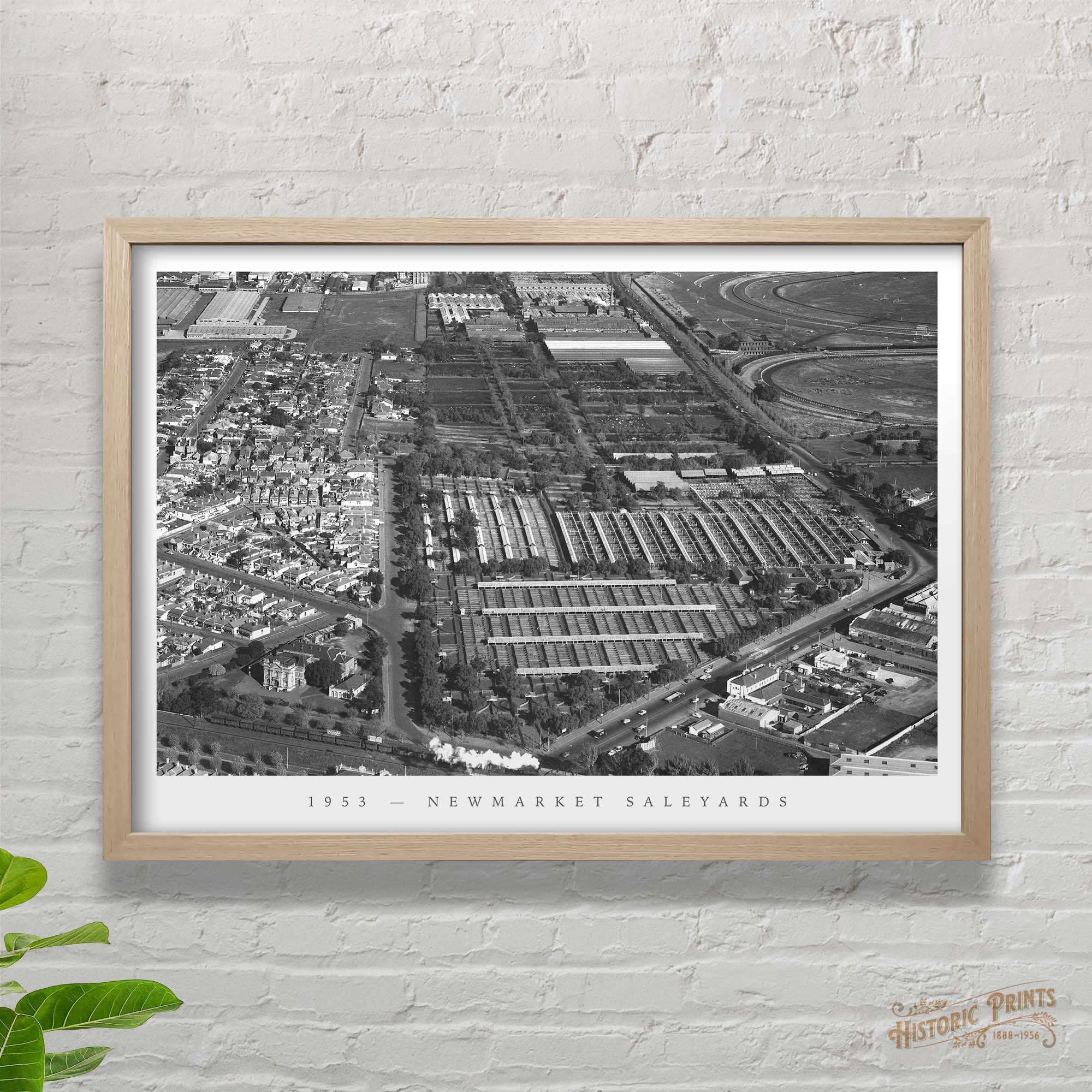 Image 1 of 10
Image 1 of 10

 Image 2 of 10
Image 2 of 10

 Image 3 of 10
Image 3 of 10

 Image 4 of 10
Image 4 of 10

 Image 5 of 10
Image 5 of 10

 Image 6 of 10
Image 6 of 10

 Image 7 of 10
Image 7 of 10

 Image 8 of 10
Image 8 of 10

 Image 9 of 10
Image 9 of 10

 Image 10 of 10
Image 10 of 10











Kensington Newmarket Salesyard Aerial Photograph 1953
An impressive aerial of the Newmarket Salesyard around 1953 when it was in its prime. If you reside in Kensington around the Town Hall to the River, then this is print for you. We also have another print from the early 1930s looking east.
The Newmarket Stock and Sale Yard History
The Newmarket Saleyards were first established in 1861, on what was then the fringe of Melbourne. The Newmarket Saleyards introduced to Melbourne an organised system of livestock auctioning for cattle, sheep, pigs and horses. The livestock market developed into a livestock industry and rapidly flourished, as did the need for drovers, stock and station agents, import and export agents, commission agents, bloodstock agents, cattle salesmen, cattle dealers, auctioneers, wool-brokers and cattle brokers.
By the 1930s, the Newmarket Saleyards had developed into the premier livestock market in Australia and were recognised as a barometer for the livestock industry in Australia, with millions of sheep, cattle, horses and other livestock passing through its red gum gates and along its bluestone laneways each year. Spread over 24 acres, Newmarket incorporated 1196 sheep pens, 232 bullock pens, 300 calf pens, drafting races, holding yards, lane outlets, transport loading and unloading ramps, and a scale weighing area.
When in operation, the Saleyards resounded to the distinctive clatter of hooves on bluestone cobbles; the bellowing of cattle; the bleating of sheep; the chatter of raised voices; auctoineers' criers; drovers' calls and whistles. Every sale day brought the auctioneers' calls for bids and responding buyers' shouts. The slam of timber gates resonated throughout the yards; while the yapping and barking of drovers' dogs intermingled with the cracking of stockwhips. Drovers herded stock to, from and around the Newmarket site, and at various times along the local streets. Millions of head of stock passed from railway sidings through drafting, receiving, penning and selling yards; from the saleyards to the adjoining abattoirs; or were loaded onto trucks to be transported around the country.
For more than 125 years the Saleyards was a thriving metropolis and the distinctive culture of Newmarket fostered a unique life integrated within the local community. The Newmarket Saleyards survived as a hub where city and country merged, a rural environment within a bustling city, a unique 'town within a town'. The Newmarket Saleyards finally closed on 1 April 1987.
An impressive aerial of the Newmarket Salesyard around 1953 when it was in its prime. If you reside in Kensington around the Town Hall to the River, then this is print for you. We also have another print from the early 1930s looking east.
The Newmarket Stock and Sale Yard History
The Newmarket Saleyards were first established in 1861, on what was then the fringe of Melbourne. The Newmarket Saleyards introduced to Melbourne an organised system of livestock auctioning for cattle, sheep, pigs and horses. The livestock market developed into a livestock industry and rapidly flourished, as did the need for drovers, stock and station agents, import and export agents, commission agents, bloodstock agents, cattle salesmen, cattle dealers, auctioneers, wool-brokers and cattle brokers.
By the 1930s, the Newmarket Saleyards had developed into the premier livestock market in Australia and were recognised as a barometer for the livestock industry in Australia, with millions of sheep, cattle, horses and other livestock passing through its red gum gates and along its bluestone laneways each year. Spread over 24 acres, Newmarket incorporated 1196 sheep pens, 232 bullock pens, 300 calf pens, drafting races, holding yards, lane outlets, transport loading and unloading ramps, and a scale weighing area.
When in operation, the Saleyards resounded to the distinctive clatter of hooves on bluestone cobbles; the bellowing of cattle; the bleating of sheep; the chatter of raised voices; auctoineers' criers; drovers' calls and whistles. Every sale day brought the auctioneers' calls for bids and responding buyers' shouts. The slam of timber gates resonated throughout the yards; while the yapping and barking of drovers' dogs intermingled with the cracking of stockwhips. Drovers herded stock to, from and around the Newmarket site, and at various times along the local streets. Millions of head of stock passed from railway sidings through drafting, receiving, penning and selling yards; from the saleyards to the adjoining abattoirs; or were loaded onto trucks to be transported around the country.
For more than 125 years the Saleyards was a thriving metropolis and the distinctive culture of Newmarket fostered a unique life integrated within the local community. The Newmarket Saleyards survived as a hub where city and country merged, a rural environment within a bustling city, a unique 'town within a town'. The Newmarket Saleyards finally closed on 1 April 1987.
